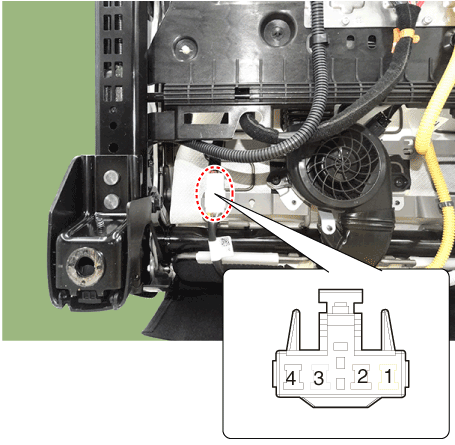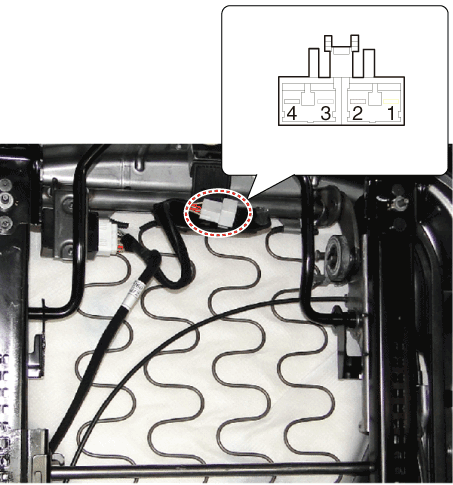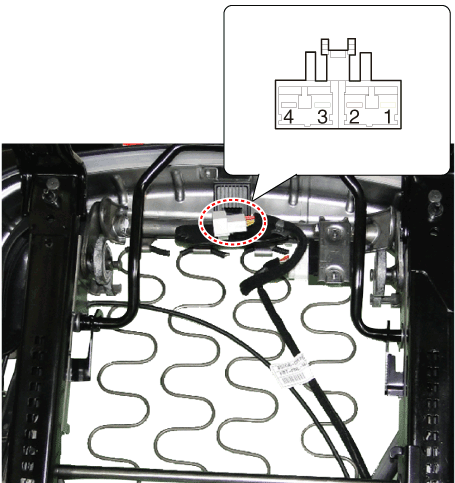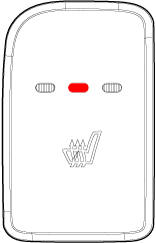Hyundai Santa Fe: Seat Electrical / Seat Heater (Non-Air Ventilation). Repair procedures
Hyundai Santa Fe (TM) 2019-2025 Service Manual / Body Electrical System / Seat Electrical / Seat Heater (Non-Air Ventilation). Repair procedures
| Inspection |
Driver/Passenger
| 1. |
Check for continuity and measure the resistance between terminals.
|
| 2. |
Operate the seat heater after connecting the connector, and then check
the thermostat by measuring the temperature of seat surface.
|
Second Line Seat Heater
| 1. |
Check for continuity and measure the resistance between terminals.
[RH]
[LH]
|
|||||||||||||||||||||
| 2. |
Operate the seat heater after connecting the connector, and then check
the thermostat by measuring the temperature of seat surface.
|
|||||||||
Diagnosis mode
| 1. |
Enter the diagnostic mode referring to below description.
|
| 2. |
After entering the diagnosis mode, you can check what failed by checking
the blinking LED.
|
| 3. |
The table below indicates the failure based on priority, upper item
means higher priority.
|
| 4. |
If more than one failure is detected, higher priority failure is displayed
through the LED flashing pattern.
|
| 5. |
Lower priority failure will be displays if higher priority failure is
reset.
[Heater Switch]
[Driver/Passenger]
[Second line seat heater]
|
| 6. |
If you press the seat heater button for more than five seconds, the
LED for malfunctioning memory will blink four times and the recorded
memory will be deleted.
|
| 7. |
Pressing the IGN OFF button will end the diagnosis mode for the seat.
|
| 8. |
You can check whether the heating seat system works properly after turning
the IGN ON. If you want to check the error code, you can refer to the
procedure of 2 above.
|
 Seat Heater (Air Ventilation). Components and components location
Seat Heater (Air Ventilation). Components and components location
Components
1. Seat cushion
heater
2. Seat heater unit (Passenger only)
3. Seat back
heater
No...
Other information:
Hyundai Santa Fe (TM) 2019-2025 Owner's Manual: Trip computer (Type B)
The trip computer is a microcomputercontrolled driver information system that displays information related to driving. Information Some driving information stored in the trip computer (for example Average Vehicle Speed) resets if the battery is disconnected...
Hyundai Santa Fe (TM) 2019-2025 Service Manual: Oil Pan. Repair procedures
Removal • Be careful not to damage the parts located under the vehicle (floor under cover, fuel filter, fuel tank and canister) when raising the vehicle using the lift...
Categories
- Manuals Home
- 4th Generation Santa Fe Owners Manual
- 4th Generation Santa Fe Service Manual
- Folding the side view mirror
- Instrument panel overview
- Side air bags
- New on site
- Most important about car
Vehicle Identification Number (VIN). Vehicle certification label. Tire specification and pressure label
Vehicle Identification Number (VIN)
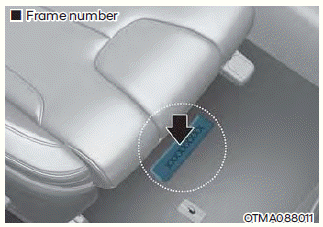
The vehicle identification number (VIN) is the number used in registering your vehicle and in all legal matters pertaining to its ownership, etc.
The number is punched on the floor under the passenger seat. To check the number, open the cover.
Copyright © 2025 www.hsafe4.com

